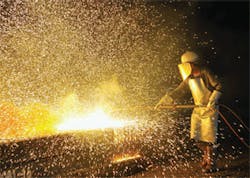When it comes to workplace safety the first line of defense against injury is a well-crafted safety program. However, when the program measures fail it is vital that manufacturing plant employees are equipped with the proper personal protective equipment (PPE) to prevent or minimize injury.
Still, determining the types of PPE your employees will need very often is a difficult process. Here are guidelines for building your final line of defense.
Needs Assessment — The first step for selecting PPE is to conduct a needs assessment. To complete this exercise, walk through your workplace, talk to the employees, and identify the hazards they must face. When noting these hazards, include the locations and the causes of the hazard so you can select PPE usage requirements.
Select the PPE — Once the hazards are defined it is time to select the PPE you will use to protect the workers. There are two types of PPE used in hot metal operations: primary and secondary.
Primary PPE is the gear employees wear over secondary PPE when there is a significant risk of exposure to heat, hot metals, and similar dangers. This type of PPE is typically worn only when dealing with the specific heightened hazard. Examples of primary PPE include safety glasses, face shields, hard hats, hearing protection, aprons, jackets, gloves, or aluminized body coverings.
Secondary PPE is worn in areas where the hazard is reduced and its basic purpose is to prevent ordinary clothing from igniting and burning. This type of equipment is typically worn for the entire shift.
Possibly the most common type of secondary PPE used in hot metal operations is flame-resistant coveralls. Here are some recommendations on PPE defined by the hazards to specific body parts.
Head — Hazards that may cause head injuries include falling objects, moving equipment, and/or overhead obstructions, as well as burns from physical contact with hot metal, sparks, f lames and/or hot surfaces. To prevent these types of injuries use hard hats that meet American National Standards Institute (ANSI) Z89.1 standards.
Face — Hot metal splashing and sparking, infrared radiation, and ultraviolet radiation from high-temperature surfaces or electric arcs, present potential for facial injuries. To protect employees from these hazards use tinted acrylic or #40 wire mesh face shields and wear safety glasses with side shields along with face protection.
Eye — To prevent injuries caused by foreign bodies, burns and/or infrared and ultraviolet radiation from high-temperature surfaces or electric arc, refer to the eye protection specification in ANSI Z87.1 (Practice for Occupational and Educational Eye and Face Protection), use minimum-protection safety glasses with side shields and darker glasses for intense radiant energy.
Hearing — The U.S. Occupational Health and Safety Administration (OSHA) requires workplaces that have noise in excess of 85 decibels for an eight-hour time frame to use hearing protection. This protection must effectively cancel out or reduce the noise to an acceptable volume level. It may be important in your operation to consider that earplugs made of foam or urethane materials may be combustible.
Hand — To prevent burns from physical contact with hot metal, sparks, f lames and/or hot surfaces, as well as scrapes, cuts and abrasions from handling charge materials, it is important for your employees to wear gloves. When selecting these gloves it is important to consider the need for dexterity and grip security when operating equipment. Recommended materials for the gloves include leather, cotton, wool, Kevlar, wool-lined Kevlar, and other heat-resistant materials. Do not use Nomex or phosphorous-treated (flame-retardant) cotton gloves as molten metal tends to stick to the fabric.
Foot — To prevent injuries from falling or rolling objects, or burns from hot metal or hot surfaces, select foot protection meeting ANSI Z41. For melting and pouring operations, a leather safety shoe with a smooth toe, such as a 6- or 8-in. engineer’s boot, is recommended. If metatarsals or lace boots are worn, select a built-in design or wear spats or leggings that cover areas where molten metal or sparks could lodge, such as in the tongue area. Wear pants or leggings that cover the top of the boot, never tucking the pant legs inside the boot or spat. Also, do not use shoes with zippers or materials such as nylon, which could melt or ignite.
Full Body — When working near radiant heat or potential molten splash hazards it is important to protect the entire body. Perhaps the most effective PPE for this task is aluminized glass outerwear. This PPE is proven to deflect about 90% of radiant heat and can shed molten splashes and sparks.
Breathing — Forging and other metal manufacturing plants present the potential for many hazardous airborne substances. To protect employees against these substances, it is vital for them to have available and to use proper respirators. Often a respirator used to guard against one chemical cannot be used effectively for another one, so carefully examine your needs and match them to the appropriate device.
When selecting both primary and secondary PPE it is important to choose equipment that properly fits employees and is comfortable to wear.
Style is also important: for example pockets and flaps create catch points, metal buttons heat up from radiant heat, and fireretardant tape can stop fabric from breathing and lead to cause sweat/burn marks if it’s not placed well on a garment. Highvisibility color options can help to promote good visibility and recognition.
Remember that after selecting your plant’s PPE it is important to train employees properly in their usage, and to implement a maintenance program that ensures the equipment is always in proper working order.
Michael Rich is a safety writer and researcher for Safety Services Co., a supplier of safety training materials and compliance products in North America. To learn more, visit www.safetyservicescompany.com.
